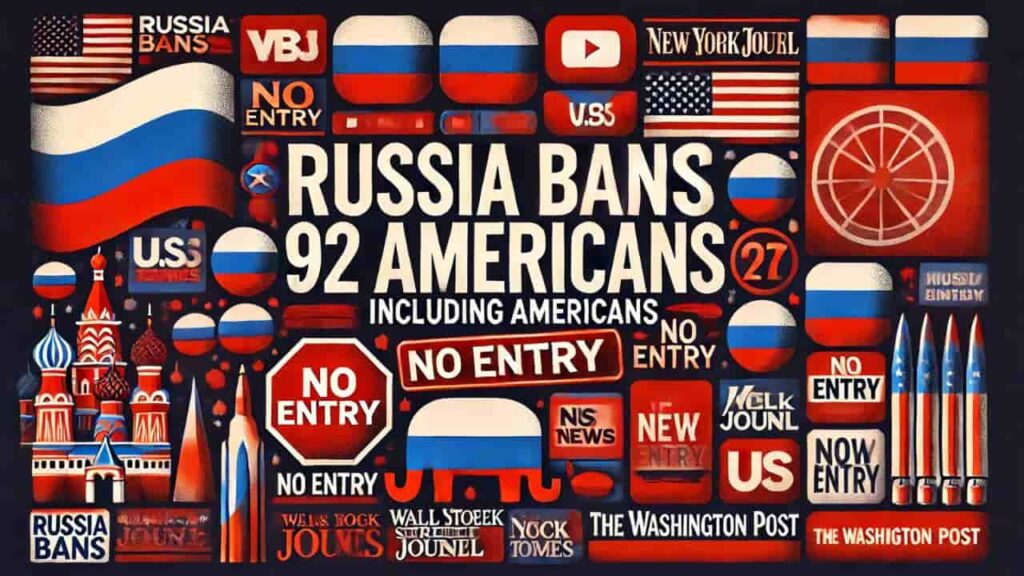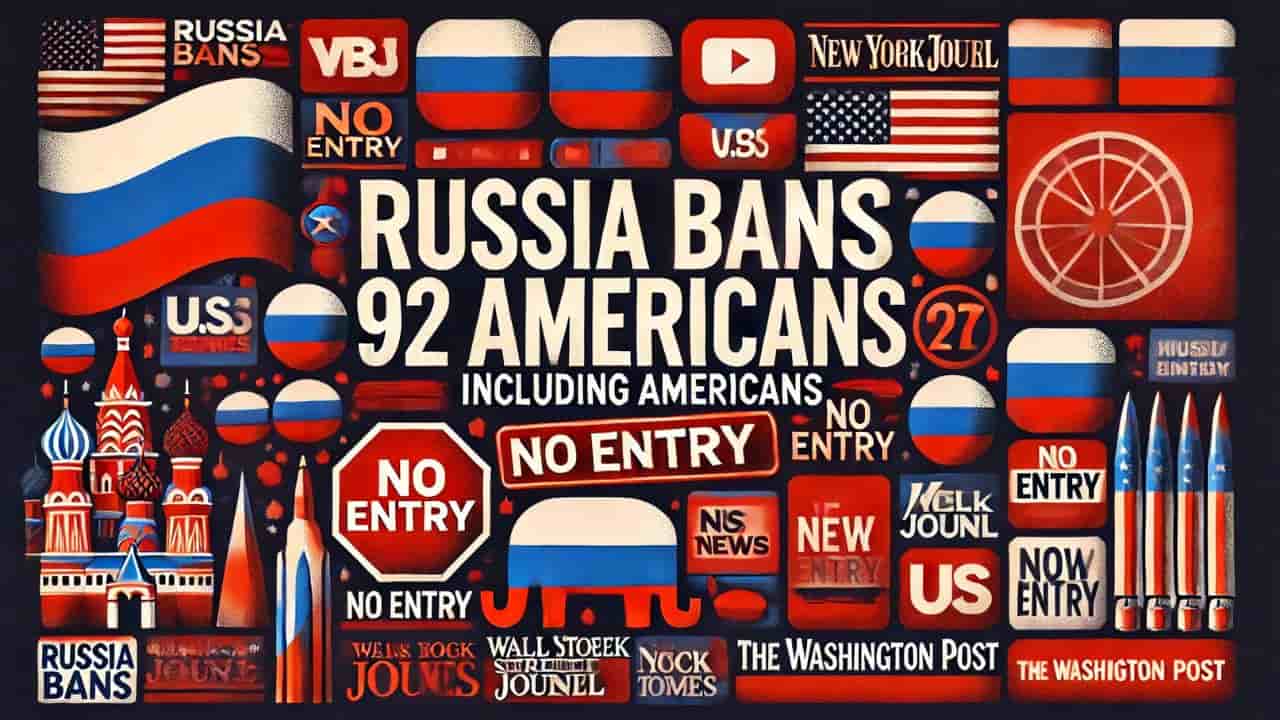Russia bans Americans, Russophobic course, U.S.-Russia relations, Russian sanctions, American journalists banned, Russia foreign ministry, U.S. sanctions, press freedom, geopolitical tensions, Russia-U.S. conflict
Russia has added 92 more Americans to its entry ban list, including prominent journalists from The Wall Street Journal, The New York Times, and The Washington Post. This move is part of Russia’s response to what it calls the U.S.’s ‘Russophobic course,’ escalating tensions between the two nations. The ban also includes law enforcement officials, business leaders, and academics.

Russia Bans 92 Americans, Including Journalists, in Response to U.S. ‘Russophobic Course’
In a significant and symbolic move, Russia’s Foreign Ministry announced on Wednesday that 92 additional American citizens have been barred from entering the country. This latest development is a response to what Russia describes as the “Russophobic course” pursued by the Biden administration, which Moscow alleges is aimed at inflicting a strategic defeat on Russia. The list of those banned includes prominent journalists, law enforcement officials, business figures, and academics.
The Context Behind Russia’s Ban
This new wave of sanctions is part of an ongoing tit-for-tat between the United States and Russia, where diplomatic relations have deteriorated to a post-Cold War low. The tension between the two nations has been fueled by various issues, including the ongoing conflict in Ukraine, allegations of election interference, and accusations of human rights violations. In response to these perceived threats, both nations have resorted to banning each other’s officials, business leaders, and journalists from entry.
Russia’s Foreign Ministry, in its official statement, made it clear that this action was in direct response to the U.S. administration’s policies. The ministry accused the Biden administration of harboring a Russophobic agenda, aimed at weakening Moscow’s strategic position on the global stage.
Targeting Journalists: A Message to the Media
Among the 92 Americans now banned from entering Russia, a significant number are journalists from some of the most respected news organizations in the United States. This includes 11 current or former staff members of The Wall Street Journal (WSJ), such as Editor-in-Chief Emma Tucker. Tucker has been a vocal critic of Russia, particularly regarding the arrest and subsequent conviction of WSJ reporter Evan Gershkovich on espionage charges. Gershkovich spent 16 months in a Russian prison before being released in a high-profile prisoner exchange in August.
The ban also extends to five journalists from The New York Times, including Kyiv Bureau Chief Andrew Kramer, and four from The Washington Post. These journalists have been involved in extensive coverage of Russia’s actions in Ukraine, the Kremlin’s domestic policies, and broader geopolitical issues. The Russian Foreign Ministry labeled these journalists as representatives of “leading liberal-globalist publications” that are allegedly involved in disseminating fake news about Russia and its military operations.
This action against journalists is not just a simple ban; it is a clear message from Moscow about how it perceives the role of Western media in shaping global narratives about Russia. By targeting high-profile journalists, Russia is underscoring its displeasure with the way its actions are reported in the West, particularly regarding the conflict in Ukraine.
Law Enforcement, Business, and Academia: Widening the Scope
The ban is not limited to journalists alone. Russia’s latest list also includes individuals from various other sectors, such as law enforcement, business, and academia. The inclusion of these figures suggests that Russia is broadening its response to what it sees as U.S. efforts to isolate and weaken it.
Law enforcement officials on the list may include those involved in investigations or sanctions against Russian entities or individuals. The inclusion of business leaders and figures from think tanks indicates Moscow’s intention to disrupt the activities of those it believes are influencing U.S. policy against Russia. By banning academics, Russia is further signaling its intent to cut off intellectual and cultural exchanges that it deems hostile.
The Broader Implications of Russia’s Actions
Russia’s decision to ban these 92 Americans is part of a broader strategy to push back against what it perceives as Western aggression. This action is not just about denying entry to certain individuals; it is a political statement meant to demonstrate Russia’s resolve in the face of mounting international pressure.
This move also reflects the increasingly polarized nature of global politics, where countries are drawing more rigid lines in the sand. The targeting of journalists, in particular, highlights the growing tension between state-controlled narratives and independent journalism. In an era where information is a critical battleground, Russia’s actions serve as a reminder of the high stakes involved in reporting the truth.
The Impact on U.S.-Russia Relations
The inclusion of journalists, law enforcement officials, business leaders, and academics in the ban list is likely to further strain relations between the U.S. and Russia. The two countries have already been engaged in a series of tit-for-tat sanctions, expulsions of diplomats, and restrictions on media and cultural exchanges. This latest move is likely to escalate the situation further.
For journalists, the ban represents a significant challenge. It restricts their ability to report on the ground in Russia, thereby limiting the flow of information from the country. This, in turn, could lead to a more insular and controlled narrative emerging from Russia, with fewer opportunities for independent verification of facts and events.
For law enforcement and business figures, the ban could complicate ongoing investigations, negotiations, and business dealings that involve Russian entities. This could have a ripple effect on international relations, trade, and law enforcement cooperation.
Academics, too, are likely to feel the impact, as the ban restricts their ability to engage in research and scholarly exchange with Russian institutions. This could hinder academic collaboration and the sharing of knowledge, further isolating Russia from the international community.
A History of Bans and Sanctions
This is not the first time Russia has imposed entry bans on American citizens. Over the past few years, Russia has steadily expanded its list of banned individuals in response to U.S. sanctions and other measures. According to the Russian Foreign Ministry, more than 2,000 Americans are currently banned from entering the country. These include politicians, military officials, business leaders, and now, increasingly, journalists and academics.
The U.S., for its part, has also imposed numerous sanctions on Russian individuals and entities in response to various actions by the Kremlin. These sanctions have targeted Russian officials, oligarchs, businesses, and even entire sectors of the Russian economy, such as energy and finance. The U.S. government has justified these sanctions as necessary to hold Russia accountable for its actions, particularly its annexation of Crimea, its involvement in the conflict in Ukraine, and its alleged interference in U.S. elections.
The back-and-forth nature of these bans and sanctions has led to a situation where both countries are increasingly isolated from each other. Diplomatic relations have become more strained, and the channels for dialogue and cooperation have narrowed. This has made it more challenging to address global issues that require collaboration, such as arms control, climate change, and counterterrorism.
The Role of Media in U.S.-Russia Relations
The media has played a significant role in shaping the narrative of U.S.-Russia relations. Western journalists, in particular, have been at the forefront of reporting on Russia’s actions, both domestically and internationally. Their coverage has often been critical of the Kremlin, highlighting issues such as human rights abuses, corruption, and military aggression.
Russia, on the other hand, has accused Western media of bias and of being part of a broader strategy to undermine its government. The Kremlin has often portrayed Western journalists as agents of influence, working to destabilize Russia by spreading disinformation and false narratives.
This latest ban on American journalists can be seen as part of Russia’s broader strategy to control the narrative and limit the influence of Western media. By banning journalists from major publications like The Wall Street Journal, The New York Times, and The Washington Post, Russia is attempting to curtail the flow of information and reduce the scrutiny it faces from the international community.
However, this strategy is not without its risks. By isolating itself from Western media, Russia may also be limiting its ability to engage with the global community and present its side of the story. In an increasingly interconnected world, where information flows freely across borders, such isolation could have long-term consequences for Russia’s international standing.
Conclusion: A Deepening Divide
Russia’s decision to ban 92 Americans, including prominent journalists, is a clear indication of the deepening divide between the U.S. and Russia. This move reflects the broader geopolitical tensions between the two countries and underscores the challenges of maintaining open channels of communication in an increasingly polarized world.
The inclusion of journalists in the ban list is particularly concerning, as it highlights the growing challenges to press freedom and the role of independent media in holding governments accountable. As the situation continues to evolve, it remains to be seen how these bans will impact U.S.-Russia relations and the broader international community.
One thing is clear: the divide between the U.S. and Russia is widening, and with each new ban, sanction, or diplomatic spat, the chances of reconciliation become more remote. In this environment, it is more important than ever for the global community to find ways to bridge the gap and foster dialogue, even in the face of deep-seated disagreements.
Read More
